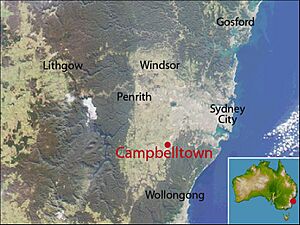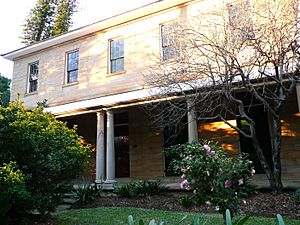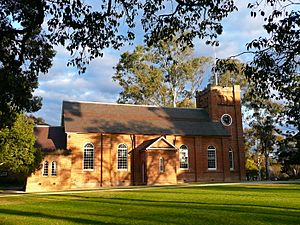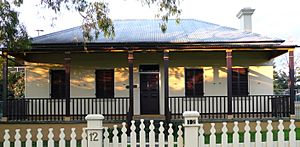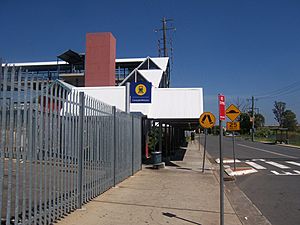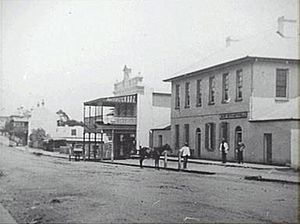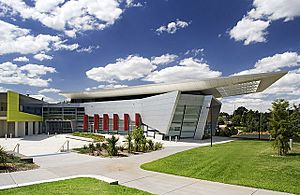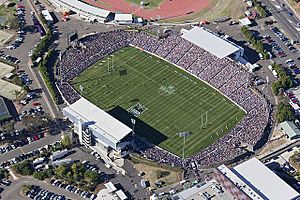Campbelltown, New South Wales facts for kids
Quick facts for kids CampbelltownSydney, New South Wales |
|||||||||||||||
|---|---|---|---|---|---|---|---|---|---|---|---|---|---|---|---|
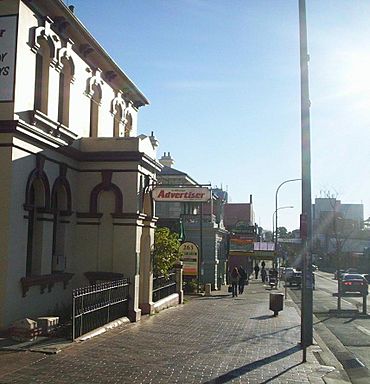
Queen Street in Campbelltown c. 2005
|
|||||||||||||||
| Established | 1820 | ||||||||||||||
| Postcode(s) | 2560 | ||||||||||||||
| Elevation | 76 m (249 ft) | ||||||||||||||
| Location |
|
||||||||||||||
| LGA(s) | Campbelltown | ||||||||||||||
| Region | Greater Western Sydney Macarthur |
||||||||||||||
| State electorate(s) | Campbelltown | ||||||||||||||
| Federal Division(s) | Macarthur | ||||||||||||||
|
|||||||||||||||
Campbelltown is a suburb located on the edge of Sydney, New South Wales, Australia. It is about 53 kilometres (33 miles) south-west of the Sydney city centre. Campbelltown is the main office area for the City of Campbelltown local government. It is also one of only four places in Sydney officially recognised as a city.
Campbelltown got its name from Elizabeth Campbell. She was the wife of Lachlan Macquarie, a former Governor of New South Wales. The name was first "Campbell-Town" but was later shortened to "Campbelltown".
Contents
History
Before European settlers arrived, the land that is now Campbelltown was home to the Tharawal people. In 1788, a small group of six cattle escaped from the early British settlement in Sydney. They were not seen by the British again for seven years.
However, the Tharawal people saw them. They even drew pictures of the cattle in a rock art site called Bull Cave near Campbelltown. In 1795, British explorers found a herd of about 60 cattle grazing in the area now known as Camden.
The government wanted the cattle herd to grow. So, they made rules against killing the cattle or settling in that area. But John Macarthur, who wanted to raise sheep, liked the good grazing land. He convinced the British government to let him have 5,000 acres (20 km²) of land in 1805. This land was just south of the Nepean River. A few years later, more land was given to farmers between Camden and Liverpool.
The Tharawal people first worked with the local farmers. But a dry period in 1814 caused many Gandangara people from nearby areas to move in, looking for food. This led to problems between the British and the Gandangara people. There were fights and people died on both sides. Governor Macquarie decided that a permanent town would help bring order. So, Campbell-Town was started in 1820.
Town Development
The town grew slowly, especially after Governor Macquarie left. It was not until 1831 that people started owning land in the town. But during this time, Campbelltown's most famous story happened.
In 1826, a local farmer named Frederick Fisher disappeared. The story says his ghost appeared on a fence over a creek south of town. The ghost pointed to a spot where his body was later found buried. To remember this event, the Fisher's Ghost festival is held every November in Campbelltown.
Campbelltown's population grew steadily over the next few decades. The southern railway line reached Campbelltown in 1858, which helped the town grow even more. In 1882, the Campbelltown Council was formed. This allowed important town projects to begin. Campbelltown was the first country town in New South Wales to have piped water in 1888. Between the World Wars, a local power station was built to provide electricity.
In the early 1960s, Campbelltown was chosen to be a "satellite city" by the New South Wales Planning Authority. This meant it would be a regional centre for south-west Sydney. A lot of building and population growth happened. The government set aside land for homes and businesses.
Geography
Climate
Campbelltown has a humid subtropical climate. This means it has mild to cool winters and warm to hot summers.
| Climate data for Campbelltown Swimming Centre, New South Wales, Australia (1962-1984 normals and extremes) | |||||||||||||
|---|---|---|---|---|---|---|---|---|---|---|---|---|---|
| Month | Jan | Feb | Mar | Apr | May | Jun | Jul | Aug | Sep | Oct | Nov | Dec | Year |
| Record high °C (°F) | 45.8 (114.4) |
43.0 (109.4) |
40.8 (105.4) |
33.9 (93.0) |
28.3 (82.9) |
25.6 (78.1) |
24.1 (75.4) |
29.0 (84.2) |
35.9 (96.6) |
36.8 (98.2) |
42.2 (108.0) |
41.0 (105.8) |
45.8 (114.4) |
| Mean daily maximum °C (°F) | 28.2 (82.8) |
28.4 (83.1) |
26.8 (80.2) |
24.1 (75.4) |
20.4 (68.7) |
17.6 (63.7) |
17.1 (62.8) |
18.7 (65.7) |
21.4 (70.5) |
23.5 (74.3) |
25.8 (78.4) |
27.9 (82.2) |
23.3 (74.0) |
| Daily mean °C (°F) | 22.5 (72.5) |
22.7 (72.9) |
20.9 (69.6) |
17.7 (63.9) |
14.0 (57.2) |
11.4 (52.5) |
10.2 (50.4) |
11.6 (52.9) |
14.2 (57.6) |
17.0 (62.6) |
19.2 (66.6) |
21.5 (70.7) |
16.9 (62.5) |
| Mean daily minimum °C (°F) | 16.7 (62.1) |
16.9 (62.4) |
15.0 (59.0) |
11.2 (52.2) |
7.6 (45.7) |
5.2 (41.4) |
3.2 (37.8) |
4.5 (40.1) |
7.0 (44.6) |
10.4 (50.7) |
12.6 (54.7) |
15.1 (59.2) |
10.5 (50.8) |
| Record low °C (°F) | 7.2 (45.0) |
6.1 (43.0) |
3.9 (39.0) |
0.0 (32.0) |
−0.6 (30.9) |
−2.0 (28.4) |
−5.6 (21.9) |
−2.5 (27.5) |
−0.6 (30.9) |
1.1 (34.0) |
2.9 (37.2) |
6.5 (43.7) |
−5.6 (21.9) |
| Average precipitation mm (inches) | 90.6 (3.57) |
78.6 (3.09) |
100.7 (3.96) |
62.6 (2.46) |
60.2 (2.37) |
81.6 (3.21) |
33.7 (1.33) |
50.4 (1.98) |
40.7 (1.60) |
74.3 (2.93) |
84.3 (3.32) |
70.5 (2.78) |
828.2 (32.6) |
| Average precipitation days (≥ 1 mm) | 8.3 | 8.1 | 8.1 | 5.5 | 5.6 | 6.4 | 4.3 | 5.6 | 5.9 | 8.4 | 7.3 | 6.4 | 79.9 |
Commercial Area
The original town centre, planned by Lachlan Macquarie, is still the main shopping area. Here you will find the Queen Street shops, Campbelltown Mall, and the Campbelltown railway station. There are also bus stops and historic buildings. The main homes are to the south and east of the town centre. On the north-west side of the railway line, there is an industrial area.
To the south-west, there is another shopping area near Macarthur railway station. This area includes the University of Western Sydney and Macarthur Square, a large shopping mall. Macarthur Square has an outdoor area called "Kellicar Lane" with restaurants and entertainment. It opened in November 2005. Its food court has big glass windows that look out over Kellicar Lane and the countryside.
Heritage Listings
Campbelltown has several places listed on the New South Wales State Heritage Register. These are important historical sites:
- Broughton Street: St John's Catholic Church, Campbelltown
- 8 Lithgow Street: Glenalvon House
- 14 - 20 Queen Street: Warbys Barn and Stables
- 261 Queen Street: Campbelltown Post Office
- 263 Queen Street: Commercial Banking Company of Sydney, Campbelltown Branch (former)
- 284 - 298 Queen Street: Queen Street Buildings
- 303 Queen Street: Dredges Cottage
Other important buildings in central Campbelltown that were once listed on the Register of the National Estate include:
- St Peter's Church of England, Cordeaux Street
- Richmond Villa, 12 Lithgow Street
- Town Hall, 315 Queen Street
- Campbelltown Court House, Queen Street
- Campbelltown Police Station, Railway Street
- Graves of Matthew Healey, James Ruse, Cemetery, George and Broughton Streets
Transport
Campbelltown is on the main road and rail routes from Sydney to the south-west. The Hume Motorway connects Campbelltown north to Liverpool, Sydney Airport, and the Sydney CBD. It also goes south to Melbourne. The B69 connects to Wollongong and Appin.
Campbelltown railway station and Macarthur railway station are on the Sydney-Melbourne railway line. Campbelltown is also the end point for most train services on the Southern Highlands Line. Campbelltown railway station opened on May 4, 1858. Electric train services started on May 5, 1968.
Campbelltown also has good bus services. Transit Systems buses go from Campbelltown Station to almost all nearby suburbs. They also go to Camden and as far north as Liverpool. Picton Buslines provides a service from Campbelltown to Picton via Camden. There is also a bus service that connects Wollongong to Campbelltown.
Education
The Western Sydney University has a campus in Campbelltown, located on Narellan Road. It started in 1983 as the second campus of the Macarthur Institute of Higher Education. This institute joined with Western Sydney University in 1989. A TAFE NSW campus is located just across from the university.
There are many local schools, including:
- Campbelltown Performing Arts High School
- Broughton Anglican College
- Campbelltown Public School
- Campbelltown East Public School
- Campbelltown North Public School
- St Patricks College Campbelltown
- John Therry Catholic High School
- St John the Evangelist Catholic Primary
- St Peter's Anglican Primary
- Robert Townson High School
- Mount Carmel Catholic College
- Robert Townson Public School
- Kearns Public School
- Blairmount Public School
- Claymore Public School
- Eaglevale High School
- Leumeah Public School
- Leumeah High School
- Rosemeadow Public School
- Ambarvale High School
- Sarah Redfern High School
- Sarah Redfern Public School
- Minto Public School
- The Grange Public School
- Campbellfield Public School
- Al Faisal College
- St. Peter's Anglican Primary School (Campbelltown)
- Airds High School
- Woodland Road Public School
In the areas around Campbelltown, there are other schools linked to the suburb. These include Broughton Anglican College, Mount Carmel High School (Varroville), Thomas Reddall High School (Ambarvale), Ambarvale High School (Rosemeadow), Menangle Park, and St Gregory's College, Campbelltown. St Gregory's College is in its own suburb, Gregory Hills.
Housing
The homes in Campbelltown are a mix of public and privately owned houses. Public housing areas are found throughout the region and nearby areas.
Population
According to the 2021 census, there were 16,577 people living in the suburb of Campbelltown. The wider Campbelltown Local Government Area had 176,519 residents.
In the suburb of Campbelltown:
- Aboriginal and Torres Strait Islander people made up 4.5% of the population.
- 58.0% of people were born in Australia. Other common birthplaces included India (3.5%), the Philippines (3.3%), New Zealand (2.9%), England (2.5%), and Bangladesh (1.9%).
- 60.3% of people spoke only English at home. Other languages spoken included Arabic (3.4%), Bengali (2.4%), Nepali (1.8%), Urdu (1.7%), and Tagalog (1.7%).
- For religion, the most common answers were No Religion (24.3%), Catholic (22.2%), Anglican (10.9%), and Islam (9.7%). Another 8.5% chose not to say their religion.
Notable Residents
Many well-known people have lived in Campbelltown, including:
- Mark Binskin – Former Chief of the Australian Defence Force
- Nicole Callisto – BMX cyclist
- Tim Campbell – Actor and TV host
- Michael Carrington – Award-winning international media executive
- Tallyn Da Silva – Australian rugby league footballer
- Bronwyn Eagles – Six-time women's hammer throw champion
- Nathan Foley – Former Hi-5 member
- Becca Hatch – Australian R&B singer
- Jarryd Hayne – Australian rugby league, rugby union, and gridiron footballer
- Brett Hodgson – Former Wests Tigers captain and rugby league coach
- Trent Hodkinson – Australian rugby league footballer
- Ryan Hoffman – Australian rugby league footballer
- Mark Hunt – New Zealand mixed martial arts fighter
- Krisnan Inu – New Zealand rugby league footballer
- Alanna Kennedy – Footballer for The Matildas and Manchester City
- Emcee Kerser – Australian rapper
- Joseph Leary – Former Australian solicitor and politician
- Peter Fitzallan MacDonald – Australian farmer, businessman, and politician
- John Marsden – Lawyer, appointed Member of the Order of Australia
- Trent Peoples – Australian rugby league footballer
- Jim Piper – Australian breaststroke swimmer
- Bruce Quick – Olympic shooter
- Kate Ritchie – Australian actress and Gold Logie winner
- James Ruse – Early settler and farmer; Ruse, New South Wales is named after him
- Yvonne Strahovski – Star of US TV series Chuck and The Handmaid's Tale
- Jai Waetford – X Factor finalist
- Lisa Wilkinson – The Project co-host on Network 10
- William Hardy Wilson – Architect, artist, and author
Culture
The Arts
The Campbelltown Arts Centre is just south of the main town centre. It has a space for performances with 180 seats, art galleries, and workshops. Outside, there is a sculpture garden and a Japanese Gardens and Teahouse. This garden was a gift from Campbelltown's sister city, Koshigaya in Japan.
Fisher's Ghost Festival
The Fisher's Ghost Festival is a yearly event that celebrates Frederick Fisher. He was a farmer in Campbelltown. The legend says that Fisher's ghost appeared to a local man after Fisher was murdered by his friend. An annual parade goes through Queen Street, Campbelltown's main street, every November. A carnival with rides and other fun is held at Bradbury Oval, a local sports ground. Over two weeks, many activities take place. These include the Fisher's Ghost Fun Run, the Fisher's Ghost Art Award, and the Street Party.
Media
Campbelltown has two local radio stations: 2MCR and C91.3FM. The two local newspapers are the Campbelltown-Macarthur Advertiser and the Macarthur Chronicle.
Sport and Recreation
Campbelltown is well known for its strong love of sports. This includes Rugby League, Cricket, Athletics, Soccer, and Australian Rules Football. Many professional athletes from Campbelltown have represented Australia at the Olympic Games.
Its top sporting team is the Wests Tigers, who play in the National Rugby League (NRL). The Wests Tigers are a team formed by joining two older clubs: the Western Suburbs Magpies and the Balmain Tigers. They play some of their home games at Campbelltown Stadium in nearby Leumeah. They also play at Leichhardt Oval in inner-western Sydney. The Magpies still play as a separate team in a lower league, the New South Wales Cup, and play home games at Campbelltown Stadium.
Macarthur FC started playing in the A-League Men (Australia's top soccer league) in late 2020. They were given a license in December 2018. The club plays its home games at Campbelltown Stadium.
Another team that uses Campbelltown Stadium is the Macarthur Rams soccer team. They play in the New South Wales Premier League. Campbelltown is also represented in the Sydney Grade Cricket competition by the Campbelltown-Camden Ghosts. They play their home games in Raby. In the Sydney AFL's Premier Division, the Campbelltown Blues play their home games in Macquarie Fields. The Campbelltown District Netball Association, located in Minto, plays in the third division of the Netball NSW State League.
See also
 In Spanish: Campbelltown para niños
In Spanish: Campbelltown para niños


